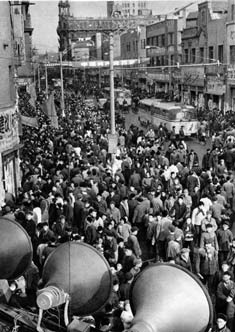Directions: Read these two documents, and answer the questions on your sheet.
Monday, March 30, 2015
Wednesday, March 25, 2015
Cultural Revolution Stations: Reflection
From these stations, you have learned that during the Cultural Revolution:
- Middle and high school students joined the Red Guards to attack opponents of the revolution (Station 1)
- People wore badges of Mao to express their love for him and support for communism (Station 2)
- The government installed radios to blast patriotic music all over the country (Station 3)
- Urban intellectuals and bureaucrats were sent to work camps for reeducation (Station 4)
- Families of people who opposed the revolution lived in fear of persecution (Station 5)
- The purpose of the Cultural Revolution was to sweep away capitalist and middle class ideas and energize people's support for communism (Station 6)
Now, let's put it all together. On your own or with a partner, respond to ONE of the three questions at this link.
Tuesday, March 24, 2015
Cultural Revolution Station 5
How the Cultural Revolution Affected My Family
Zhang Jingjing is a leading public interest lawyer in China. In this video, she describes the impact of the Cultural Revolution on her family.
Cultural Revolution Station 4
Re-education Camps
During the Cultural Revolution, urban intellectuals and government bureaucrats were sent to work camps in the countryside. At these camps, called 7 May Cadre Schools, people who were used to working in offices experienced what it's like to perform hard labor in the fields all day.
The camps had two purposes. First, they taught the urban intellectuals and bureaucrats the value of hard work. These camps were sometimes called "re-education camps" because of their goal of "re-educating" the middle class about the importance of farm labor. Second, they removed from the cities people who might pose a threat to the Communist government.
Conditions in the camps were often very poor. Often the camps did not produce enough food, and some people died in the camps.
Image #1
Image #2
Image #3
During the Cultural Revolution, urban intellectuals and government bureaucrats were sent to work camps in the countryside. At these camps, called 7 May Cadre Schools, people who were used to working in offices experienced what it's like to perform hard labor in the fields all day.
The camps had two purposes. First, they taught the urban intellectuals and bureaucrats the value of hard work. These camps were sometimes called "re-education camps" because of their goal of "re-educating" the middle class about the importance of farm labor. Second, they removed from the cities people who might pose a threat to the Communist government.
Conditions in the camps were often very poor. Often the camps did not produce enough food, and some people died in the camps.
Image #1
Image #2
Image #3
Cultural Revolution Station 3
Cultural Revolution Radio
The Cultural Revolution radio provides some examples of music typically heard on Chinese radio during the 1960's.
Radio also served as an important political tool, beginning with the Chinese Civil War. Mao said, "People in all the liberated areas should listen to the Yunnan broadcast regularly. If they haven't got a radio receiver set, they should try every means to get one."
During the Cultural Revolution, radio broadcasting played a key role in the mobilization of the masses, carrying Mao's authoritative instructions. Perhaps the most innovative development in the Communists' political use of broadcasting was that of the so-called wired public loudspeakers, which aimed at direct reception by each household in China's vast countryside... In the early 1970s, 70 million loudspeakers were installed nationwide... in such public places as school playgrounds, factories, rice paddies, and in rural villages and urban areas. Anybody who visited China during those years would find a common sight -- large loudspeakers hanging on telephone poles, building roofs and treetops. |  |
["Broadcasting and Politics: Chinese television in the Mao Era, 1958-1976," by Yu Huangxu,Historical Journal of Film, Radio, and Television, Oct. 1997.] Retrieved from: www.morningsun.org/living/radio.html.
Cultural Revolution Station 2

Mao Badges
During the Cultural Revolution, many Chinese people (like the man at right) wore badges with the image of Mao Zedong. People wore these badges to show their support for Mao and the revolution. Follow the links below to see pictures of badges and to learn more about them.
- Pictures of badges
- Information about badges (from a Chinese newspaper article from 1968)
Friday, March 13, 2015
Thursday, March 12, 2015
Underground Art in the Soviet Union
Scroll down to find your artwork in glorious color!
4.1A: Black Sun
4.1B Stalin's Funeral
4.1C: Double Self-Portrait
4.1 D: Yalta Conference
4.1E: Monument to Lenin
4.1F: Directions
4.1 G: Happy Holidays, Comrades!
4.1A: Black Sun
4.1B Stalin's Funeral
4.1C: Double Self-Portrait
4.1 D: Yalta Conference
4.1E: Monument to Lenin
4.1F: Directions
4.1 G: Happy Holidays, Comrades!
Monday, March 9, 2015
Socialist Realist Art
Click here to see examples of socialist realist art.
If the link doesn't work, copy and paste this text to see the examples:
https://drive.google.com/file/d/0B6rMqeNOB4V4MnJVUC1fbzNDbmM/view?usp=sharing
If the link doesn't work, copy and paste this text to see the examples:
https://drive.google.com/file/d/0B6rMqeNOB4V4MnJVUC1fbzNDbmM/view?usp=sharing
Subscribe to:
Posts (Atom)









